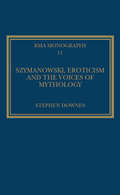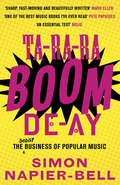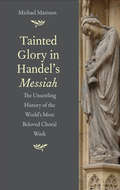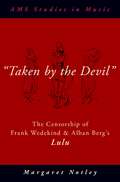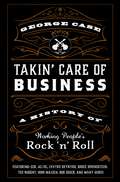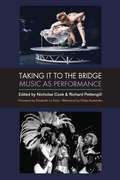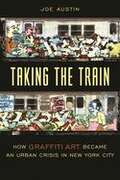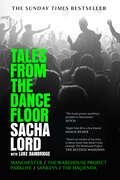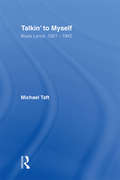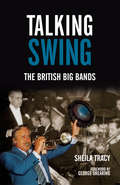- Table View
- List View
Szymanowski, Eroticism and the Voices of Mythology
by Stephen DownesThe desire to voice the artistic revelation of the truth of a precarious, multi-faceted, yet integrated self lies behind much of Szymanowski's work. This self is projected through the voices of deities who speak languages of love. The unifying figure is Eros, who may be embodied as Dionysus, Christ, Narcissus or Orpheus, and the gospel he proclaims tells of the resurrection and freedom of the desiring subject. This book examines Szymanowski's exploration of the relationship between the authorial voice, mythology and eroticism within the context of the crisis of the modern subject in Western culture. Stephen Downes analyses mythological and erotic aspects of selected songs from the composer's early career, moving to an interpretation of the voice of the homoerotic lover, embodied as a mad muezzin, in terms of heroic notions of Orphic elegy. Discussing the encounters of King Roger with the voices of Narcissus, the Siren and Dionysus, Downes shows how the composer uses the unifying Christ/Eros figure as a means of indicating that the King might be transformed from anguished despot to loving expressive subject. The book ends with an examination of Szymanowski's desire to fuse Slavonic and Middle-Eastern mythological inspirations in an attempt to fulfil a utopian vision of a pan-European culture bound together by the spirit of Eros.
Ta-Ra-Ra-Boom-De-Ay: The dodgy business of popular music
by Simon Napier-BellLet legendary rock manager Simon Napier-Bell take you inside the (dodgy) world of popular music – not just a creative industry, but a business that has made people rich beyond their wildest dreams.He balances seductive anecdotes – pulling back the curtain on the gritty and absurd side of the industry – with an insightful exploration of the relationship between creativity and money. This book describes the evolution of the industry from 1713 – the year parliament granted writers ownership over what they wrote – to today, when a global, 100 billion pound industry is controlled by just three major players: Sony, Universal and Warner. Inside you will uncover some little-known facts about the industry, including:How a formula for writing hit songs in the 1900s helped create 50,000 of the best-known songs of all time.How infighting in the American pre-war music industry shut down traditional radio and created an opening for country music, race records and rock'n'roll.How Jewish immigrants and black jazz musicians dancing cheek-to-cheek created a template for all popular music that followed.How rock tours became the biggest, quickest, sleaziest and most profitable ventures the music industry has ever seen.After reading Ta-Ra-Ra-Boom-De-Ay, you'll never listen to music in the same way again.
Taarab Music in Zanzibar in the Twentieth Century: A Story of ‘Old is Gold’ and Flying Spirits (SOAS Studies in Music Series)
by Janet Topp FargionThe musical genre of taarab is played for entertainment at weddings and other festive occasions all along the Swahili Coast in East Africa. Taarab contains all the features of a typical 'Indian Ocean' music, combining influences from Egypt, the Arabian Peninsula, India and the West with local musical practices. In Taarab, Music in Zanzibar, Janet Topp Fargion traces the development of the genre in Zanzibar, from the late nineteenth century to the end of the twentieth. Of special interest is the role of women. Although men play the main role in the composition and performance of the genre, Topp Fargion argues that the modernization of the genre owes a debt to the participation of women - as audiences and primary consumers, but also as poets and innovators of musical concepts. The book weaves together the historical, social, economic, religious and political dynamics involved in the development of the genre, and investigates how these are played out in the performance of taarab music on Zanzibar.
Taarab Music in Zanzibar in the Twentieth Century: A Story of ‘Old is Gold’ and Flying Spirits (SOAS Studies in Music Series)
by Janet Topp FargionThe musical genre of taarab is played for entertainment at weddings and other festive occasions all along the Swahili Coast in East Africa. Taarab contains all the features of a typical 'Indian Ocean' music, combining influences from Egypt, the Arabian Peninsula, India and the West with local musical practices. In Taarab, Music in Zanzibar, Janet Topp Fargion traces the development of the genre in Zanzibar, from the late nineteenth century to the end of the twentieth. Of special interest is the role of women. Although men play the main role in the composition and performance of the genre, Topp Fargion argues that the modernization of the genre owes a debt to the participation of women - as audiences and primary consumers, but also as poets and innovators of musical concepts. The book weaves together the historical, social, economic, religious and political dynamics involved in the development of the genre, and investigates how these are played out in the performance of taarab music on Zanzibar.
Tainted Glory in Handel's Messiah: The Unsettling History of the World's Most Beloved Choral Work
by Michael MarissenEvery Easter, audiences across the globe thrill to performances of Handel’s “Hallelujah Chorus,” but they would probably be appalled to learn the full extent of the oratorio’s anti-Judaic message. In this pioneering study, respected musicologist Michael Marissen examines Handel’s masterwork and uncovers a disturbing message of anti-Judaism buried within its joyous celebration of the divinity of the Christ. Discovering previously unidentified historical source materials enabled the author to investigate the circumstances that led to the creation of the Messiah and expose the hateful sentiments masked by magnificent musical artistry—including the famed “Hallelujah Chorus,” which rejoices in the “dashing to pieces” of God’s enemies, among them the “people of Israel.” Marissen’s fascinating, provocative work offers musical scholars and general readers alike an unsettling new appreciation of one of the world’s best-loved and most widely performed works of religious music.
Take Nothing For Granted: Tales from an Unexpected Life
by Ross Kemp'These are the stories of some of the things that have happened to me: the funny things, the scary things, the exciting things; the things that have made me who I am. I don't want to start at the beginning and tell them in chronological order because that's not the way my brain works. And this certainly isn't going to be one of those books of life lessons . . .'I've always been passionate about finding and telling stories. And now, for the first time, here are mine.'Famous for his portrayal of TV hardman Grant Mitchell and as the maker of documentaries exploring the most dangerous people and places on the planet, BAFTA-winning Ross Kemp is one of the UK's best known TV stars. Here, Ross shares tales from his remarkable life.From his childhood in Essex, where he used to pretend the woods behind his house were the Amazon rainforest, to finding himself travelling through the real thing thirty years later, Ross's life has taken many twists and turns. Through it all there's been no plan, no roadmap, no strategy. Ross has gone from one wild adventure to the next, and never quite felt like he's fitted in anywhere.From getting lost at sea to setting a sacred island on fire, auditioning for his part on EastEnders to filming in active war zones across the world, these are the heart-warming, hilarious and hard-hitting stories of some of the unexpected adventures that have happened along the way.Warm, energetic and endlessly entertaining, it is a fascinating snapshot of a life lived to the full.
Take Off: The humble beginnings of a Pop sensation
by Conor MaynardConor Maynard shot to fame posting cover versions of Usher, Drake and the Kings of Leon on YouTube. He soon developed a big following and he has become a huge YouTube sensation, with millions of followers. Conor's talent was quick to catch people's attention and having been spotted by international artists like Ne-Yo and Pharell Williams, he went on to record his debut album Contrast which shot straight to number one in the UK charts. Unlike many of his chart contemporaries, Conor didn't reach the charts through the X Factor, he started out making music in his bedroom and was one of the first people to find success on YouTube. In his autobiography, Conor Maynard shares his own honest, candid and often surprising take on his rapid rise to the top. The book offers exclusive behind the scenes access allowing you to get closer to the star than ever before. The book features hundreds of exclusive brand new and unseen photos and a collection of handwritten lyrics and notes.
"Taken by the Devil": The Censorship of Frank Wedekind and Alban Berg's Lulu (AMS Studies in Music)
by Margaret NotleyCensorship had an extraordinary impact on Alban Berg's opera Lulu, composed by the Austrian during the politically tumultuous years spanning 1929 to 1935. Based on plays by Frank Wedekind that were repeatedly banned from being published and performed from 1894 until the end of World War I, the libretto was in turn censored by Berg himself when he characterized it as a morality play after submitting it to authorities in Nazi Germany in 1934. After Berg died the next year, the third act was censored by his widow, Helene, and his former teacher, Arnold Schoenberg. In "Taken by the Devil", author Margaret Notley uncovers the unusual and uniquely generative role of censorship throughout the lifecycle of Berg's great opera. Placing the opera and its source material in wider cultural contexts, Notley provides close readings of the opera's libretto and score to reveal techniques employed by the composer and by Wedekind before him in negotiating censorship. She also explores ways in which Berg chose to augment discrepancies between the plays rather than flatten them as in certain performances of the plays during the 1920s, adding further dimensions of interpretation to the work. Elegantly readable, "Taken by the Devil" is one of the most meticulously researched and nuanced studies of Lulu to date, and illuminates the process of politically-driven censorship of theater, music, and the arts during the tumultuous early twentieth century.
"Taken by the Devil": The Censorship of Frank Wedekind and Alban Berg's Lulu (AMS Studies in Music)
by Margaret NotleyCensorship had an extraordinary impact on Alban Berg's opera Lulu, composed by the Austrian during the politically tumultuous years spanning 1929 to 1935. Based on plays by Frank Wedekind that were repeatedly banned from being published and performed from 1894 until the end of World War I, the libretto was in turn censored by Berg himself when he characterized it as a morality play after submitting it to authorities in Nazi Germany in 1934. After Berg died the next year, the third act was censored by his widow, Helene, and his former teacher, Arnold Schoenberg. In "Taken by the Devil", author Margaret Notley uncovers the unusual and uniquely generative role of censorship throughout the lifecycle of Berg's great opera. Placing the opera and its source material in wider cultural contexts, Notley provides close readings of the opera's libretto and score to reveal techniques employed by the composer and by Wedekind before him in negotiating censorship. She also explores ways in which Berg chose to augment discrepancies between the plays rather than flatten them as in certain performances of the plays during the 1920s, adding further dimensions of interpretation to the work. Elegantly readable, "Taken by the Devil" is one of the most meticulously researched and nuanced studies of Lulu to date, and illuminates the process of politically-driven censorship of theater, music, and the arts during the tumultuous early twentieth century.
Takin' Care of Business: A History of Working People's Rock 'n' Roll
by George CaseBy the early 1970s, practically everyone under a certain age liked rock music, but not everyone liked it for the same reasons. We typically associate the sounds of classic rock 'n' roll with youthful rebellion by juvenile delinquents, student demonstrators, idealistic hippies, or irreverent punks. But in this insightful and timely book, author George Case shows how an important strain of rock music from the late 1960s onward spoke to and represented an idealized self-portrait of a very different audience: the working-class 'Average Joes' who didn't want to change the world as much as they wanted to protect their perceived place within it. To the extent that "working-class populism" describes an authentic political current, it's now beyond a doubt that certain musicians and certain of their songs helped define that current. By now, rock 'n' roll has cast a long shadow over hundreds of millions of people around the world not just over reckless kids, but over wage-earning parents and retired elders; not just over indignant youth challenging authority, but over indignant adults challenging their own definition of it. Not only have the politics of rock fans drifted surprisingly rightward since 1970; some rock, as Case argues, has helped reset the very boundaries of left and right themselves. That God, guns, and Old Glory can be understood to be paid fitting tribute in a heavy guitar riff delivered by a long-haired reprobate in blue jeans but that #Me Too, Occupy Wall Street or Black Lives Matter might not hints at where those boundaries now lie.
Takin' Care of Business: A History of Working People's Rock 'n' Roll
by George CaseBy the early 1970s, practically everyone under a certain age liked rock music, but not everyone liked it for the same reasons. We typically associate the sounds of classic rock 'n' roll with youthful rebellion by juvenile delinquents, student demonstrators, idealistic hippies, or irreverent punks. But in this insightful and timely book, author George Case shows how an important strain of rock music from the late 1960s onward spoke to and represented an idealized self-portrait of a very different audience: the working-class 'Average Joes' who didn't want to change the world as much as they wanted to protect their perceived place within it. To the extent that "working-class populism" describes an authentic political current, it's now beyond a doubt that certain musicians and certain of their songs helped define that current. By now, rock 'n' roll has cast a long shadow over hundreds of millions of people around the world not just over reckless kids, but over wage-earning parents and retired elders; not just over indignant youth challenging authority, but over indignant adults challenging their own definition of it. Not only have the politics of rock fans drifted surprisingly rightward since 1970; some rock, as Case argues, has helped reset the very boundaries of left and right themselves. That God, guns, and Old Glory can be understood to be paid fitting tribute in a heavy guitar riff delivered by a long-haired reprobate in blue jeans but that #Me Too, Occupy Wall Street or Black Lives Matter might not hints at where those boundaries now lie.
Taking It to the Bridge: Music as Performance
by Nicholas Cook Richard PettengillThe overriding aim of this groundbreaking volume—whether the subject is vocal ornamentation in 19th-century opera or the collective improvisation of the Grateful Dead—is to give new recognition to performance as the core of musical culture. The collection brings together renowned scholars from performance studies and musicology (including Philip Auslander, David Borgo, Daphne Brooks, Nicholas Cook, Maria Delgado, Susan Fast, Dana Gooley, Philip Gossett, Jason King, Elisabeth Le Guin, Aida Mbowa, Ingrid Monson, Roger Moseley, Richard Pettengill, Joseph Roach, and Margaret Savilonis), with the intent of sparking a productive new dialogue on music as performance. Taking It to the Bridge is on the one hand a series of in-depth studies of a broad range of performance artists and genres, and on the other a contribution to ongoing methodological developments within the study of music, with the goal of bridging the approaches of musicology and performance studies, to enable a close, interpretive listening that combines the best of each. At the same time, by juxtaposing musical genres that range from pop and soul to the classics, and from world music to games and web-mediated performances, Taking It to the Bridge provides an inventory of contrasted approaches to the study of performance and contributes to its developing centrality within music studies.
Taking Popular Music Seriously: Selected Essays
by Simon FrithAs a sociologist Simon Frith takes the starting point that music is the result of the play of social forces, whether as an idea, an experience or an activity. The essays in this important collection address these forces, recognising that music is an effect of a continuous process of negotiation, dispute and agreement between the individual actors who make up a music world. The emphasis is always on discourse, on the way in which people talk and write about music, and the part this plays in the social construction of musical meaning and value. The collection includes nineteen essays, some of which have had a major impact on the field, along with an autobiographical introduction.
Taking Popular Music Seriously: Selected Essays
by Simon FrithAs a sociologist Simon Frith takes the starting point that music is the result of the play of social forces, whether as an idea, an experience or an activity. The essays in this important collection address these forces, recognising that music is an effect of a continuous process of negotiation, dispute and agreement between the individual actors who make up a music world. The emphasis is always on discourse, on the way in which people talk and write about music, and the part this plays in the social construction of musical meaning and value. The collection includes nineteen essays, some of which have had a major impact on the field, along with an autobiographical introduction.
Taking The Train: How Graffiti Art Became An Urban Crisis In New York City (Popular Cultures, Everyday Lives Ser.)
by Joe AustinIn the 1960s and early 1970s, young people in New York City radically altered the tradition of writing their initials on neighborhood walls. Influenced by the widespread use of famous names on billboards, in neon, in magazines, newspapers, and typographies from advertising and comics, city youth created a new form of expression built around elaborately designed names and initials displayed on public walls, vehicles, and subways. Critics called it "graffiti," but to the practitioners it was "writing." Taking the Traintraces the history of "writing" in New York City against the backdrop of the struggle that developed between the city and the writers. Austin tracks the ways in which "writing" -- a small, seemingly insignificant act of youthful rebellion -- assumed crisis-level importance inside the bureaucracy and the public relations of New York City mayoral administrations and the Metropolitan Transportation Authority for almost two decades. Taking the Trainreveals why a global city short on funds made "wiping out graffiti" an expensive priority while other needs went unfunded. Although the city eventually took back the trains, Austin eloquently shows how and why the culture of "writing" survived to become an international art movement and a vital part of hip-hop culture.
Tales from the Dancefloor: Manchester / The Warehouse Project / Parklife / Sankeys / The Haçienda
by null Sacha LordLike most Mancunians of his age, Sacha Lord's life has been a tale of two cities. Then and now. Over the past three decades, Sacha has been in the eye of the storm of a musical and cultural revolution, from The Haçienda to The Warehouse Project. He has worked with the music industry’s most iconic acts including the Prodigy, New Order, Snoop Dogg, Fat Boy Slim, Skrillex, Calvin Harris, Four Tet, Fred again … and has thrown some of the biggest parties that the UK has ever seen. But it wasn’t an easy journey getting there. Tales from the Dancefloor gives readers an all-access pass to the people, music and chaos behind the scenes. From being shot at in a drive-by shooting and dealing with gangs and the criminal underworld, to the excess and demands of some of music’s biggest names, launching the country’s largest urban festival, Parklife, and much more, Sacha reveals all the highs and lows for the very first time. Tales from the Dancefloor, co-authored with bestselling author Luke Bainbridge, is a love letter to the city and the dance floor. This is an incredible story of resilience, creativity and innovation.
Talk About a Dream: The Essential Interviews of Bruce Springsteen
by Christopher Phillips Louis P. MasurBruce Springsteen often prefers to let his music do the talking. His onstage stories and shaggy dog tales have long entertained his fans, but his songs and his guitar provide the most direct line to their hearts. Considering his prominence on the rock 'n' roll landscape, Springsteen has spent remarkably little of his 40-year recording career speaking to the press. But when he does decide to sit down and talk, the conversations tend to be momentous. Q&As with Bruce Springsteen reveal an artist with great insight and self-awareness, a student of music, an avid searcher, an astute observer of humanity from the boardwalk to America at large. Much has been written about the Boss, but few can be said to know the man as well as he knows himself, and the best of Springsteen's own words are collected here in Talk About a Dream. Gathering more than 30 different interviews spanning from 1973 to 2013, this volume captures his remarkable personality-one that takes interviews as seriously as making music. These eye-opening conversations chart Springsteen's development as an artist, a thinker, and a public figure, shedding light on everything from the meaning of lyrics to his evolution from rebel rocker to global icon.
Talkin' Greenwich Village: The Heady Rise and Slow Fall of America's Bohemian Music Capital
by David BrowneThe definitive history of the rise and heyday of the revolutionary Greenwich Village music scene, based on new research and first-hand interviews with many of its legendary performers Although Greenwich Village encompasses less than a square mile in downtown New York, rarely has such a concise area nurtured so many innovative artists and genres. Over the course of decades, Billie Holiday, the Weavers, Sonny Rollins, Dave Van Ronk, Ornette Coleman, Bob Dylan, Nina Simone, Phil Ochs, and Suzanne Vega are just a few who migrated to the Village, recognizing it as a sanctuary for visionaries, non-conformists, and those looking to reinvent themselves. Working in the Village&’s smokey coffeehouses and clubs, they chronicled the tumultuous Sixties, rewrote jazz history, and took folk and rock & roll into places they hadn&’t been before. Based on over 150 new interviews (Judy Collins, Sonny Rollins, Herbie Hancock, Eric Andersen, Suzzy and Terre Roche, Suzanne Vega, Steve Forbert, Arlo Guthrie, John Sebastian, Shawn Colvin, the members of the Blues Project, and more), previously unseen documents, and author David Browne&’s longtime immersion in the scene, Talkin&’ Greenwich Village lends the saga the epic, panoramic scope it&’s long deserved. It takes readers from the Fifties jamborees in Washington Square Park and into landmark venues like Gerde&’s Folk City, the Gaslight Café, and the Village Vanguard, onto Dylan&’s momentous arrival and returns, the no-holds-barred Seventies years (West Village discos, National Lampoon&’s Lemmings), and the folk revival of the Eighties (Vega&’s enduring &“Tom&’s Diner&”). In eye-opening fashion, Browne also details the often-overlooked people of color in the Sixties folk clubs, reveals how the FBI and city government consistently kept their eyes on the community, unearths the machinations behind the infamous &“beatnik riot&” in Washington Square Park, and tells the interconnected tales of Van Ronk, the seminal band the Blues Project, and the beloved sister trio, the Roches. In also recounting the racial tensions, crackdowns, and changes in New York and music that infiltrated the neighborhood, Talkin&’ Greenwich Village is more than just vivid cultural history. It also speaks to the rise and waning of bohemian culture itself, set to some of the most enduring lyrics, melodies, and jazz improvisations in American music.
Talkin' to Myself: Blues Lyrics, 1921-1942
by Michael TaftTalkin' to Myself: Blues Lyrics, 1921-1942 is a compendium of lyrics by the great blues recording artists of the classic blues era. It includes over 2000 songs, transcribed directly from the original recordings, making it by far the most comprehensive and accurate collection of blues lyrics available.
Talkin' to Myself: Blues Lyrics, 1921-1942
by Michael TaftTalkin' to Myself: Blues Lyrics, 1921-1942 is a compendium of lyrics by the great blues recording artists of the classic blues era. It includes over 2000 songs, transcribed directly from the original recordings, making it by far the most comprehensive and accurate collection of blues lyrics available.
Talking Heads' Fear of Music (33 1/3)
by Jonathan LethemIt's the summer of 1979. A fifteen-year-old boy listens to WNEW on the radio in his bedroom in Brooklyn. A monotone voice (it's the singer's) announces into dead air in between songs "The Talking Heads have a new album, it's called Fear of Music" - and everything spins outward from that one moment. Jonathan Lethem treats Fear of Music (the third album by the Talking Heads, and the first produced by Brian Eno) as a masterpiece - edgy, paranoid, funky, addictive, rhythmic, repetitive, spooky and fun. He scratches obsessively at the album's songs, guitars, rhythms, lyrics, packaging, downtown origins, and legacy, showing how Fear of Music hints at the directions (positive and negative) the band would take in the future. Lethem transports us again to the New York City of another time - tackling one of his great adolescent obsessions and illuminating the ways in which we fall in and out of love with works of art.
Talking Heads' Fear of Music (33 1/3)
by Jonathan LethemIt's the summer of 1979. A fifteen-year-old boy listens to WNEW on the radio in his bedroom in Brooklyn. A monotone voice (it's the singer's) announces into dead air in between songs "The Talking Heads have a new album, it's called Fear of Music" - and everything spins outward from that one moment. Jonathan Lethem treats Fear of Music (the third album by the Talking Heads, and the first produced by Brian Eno) as a masterpiece - edgy, paranoid, funky, addictive, rhythmic, repetitive, spooky and fun. He scratches obsessively at the album's songs, guitars, rhythms, lyrics, packaging, downtown origins, and legacy, showing how Fear of Music hints at the directions (positive and negative) the band would take in the future. Lethem transports us again to the New York City of another time - tackling one of his great adolescent obsessions and illuminating the ways in which we fall in and out of love with works of art.
Talking Swing: The British Big Bands
by Sheila TracyFrom Palace to Palais, the musicians who played in the big bands tell their own stories, bringing to life an unforgettable era.Pre-war reminiscences give an insight into a never-to-be-forgotten era, when London's nightclubs were the haunts of the aristocracy and of royalty, and the Prince of Wales would jump at any opportunity to play drums with the resident band. The elegant world of top hat, white ties and tails has gone for ever, but in Talking Swing the musicians relive those nights when they played for as long as the customers wanted to dance - often into the early hours of the morning. Out of London, there were the variety tours, where the band was top of the bill and there wasn't an empty seat in the house.The problems faced by British musicians during the war years, when London's society bands continued to play throughout the Blitz, were enormous, and they are vividly portrayed in Talking Swing.Amongst those recalled are Ambrose, Jack Hylton, Geraldo, Ted Heath and Syd Lawrence, who took over when almost everyone else had packed it in and who kept on swinging against all odds. This was the golden age of the big bands, and the story of those days is told by the men and women who made the music.
The Tall Short Stories of… (Rough Trade Edition)
by James EndeacottJames Endeacott is the teller of many tales. The Tall Short Stories of James Endeacott range from psychedelic experiences when he was in the band Loop to making dreams come true as a judge on The X Factor, or looking after The Libertines at the beginning of their musical career and hanging out with Robert De Niro lookalikes in New York with The Strokes.
Tallinn '67 Jazz Festival: Myths and Memories
by Heli ReimannTallinn ’67 Jazz Festival: Myths and Memories explores the legendary 1967 jazz gathering that centered Tallinn, Estonia as the jazz capital of the USSR and marked both the pinnacle of a Soviet jazz awakening as well as the end of a long series of evolutionary jazz festivals in Estonia. This study offers new insights into what was the largest Soviet jazz festival of its time through an abundance of collected materials – including thousands of pages of archival documents, more than a hundred hours of interviews and countless media reviews and photographs – while grappling with the constellation of myths integral to jazz discourse in an attempt to illuminate ‘how it really was’. Accounts from musicians, jazz fans, organisers and listeners bring renewed life to this transcultural event from more than half a century ago, framed by scholarly discussions contextualizing the festival within the closed conditions of the Cold War. Tallinn ’67 Jazz Festival details the lasting international importance of this confluence of Estonian, Soviet and American jazz and the ripple effects it spread throughout the world.
